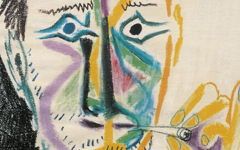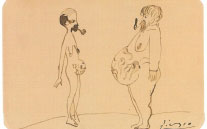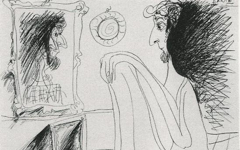Picasso’s La Toilette (1906)
Meyer Schapiro described La Toilette as an allegory of art with the mirror representing both “palette and canvas” and the mirror-holder as the painter himself.1 It is surprising then that writers have had so much trouble identifying the mirror-bearer's face which Pepe Karmel says is a combination of Fernande, Picasso’s girlfriend at the time, and a girl in a contemporaneous drawing.2 Yet if one looks at a study for the painting…..
Click next thumbnail to continue

Left: Detail of Picasso, Study for La Toilette; Right: Photograph of Picasso aged 15 (1896)
Click image to enlarge.
…the face is clearly that of the young Picasso as those of the other figures probably are too, at least a fusion of his features.
Click next thumbnail to continue

Left: Detail of Picasso, Study for La Toilette; Right: Photograph of Picasso by Roberto Otero
Click image to enlarge.
Even when compared to a much later photograph of the artist the resemblance remains. Thus John Richardson’s observation that the sash around her waist was worn by Spanish men, not women, must be correct. It is a symbol of the figure’s androgyny.3
Click next thumbnail to continue
Karmel has also noted of the study that while the mirror-bearer is copied from other images, the nude’s figure was probably modeled from life. Whether she was or not, Picasso must have made her look that way in order to differentiate the artist on one level of reality and the “drawing” on the other. Ironically, the implication is that the “artist” is taken from art while the "art" is taken from life. Of course, as the mirror suggests, the model looks back at the artist and sees herself, another take on the idea that the artist and model are one.
Click next thumbnail to continue
1. Meyer Schapiro, "Picasso's Woman with a Fan: On Transformation and Self-Transformation" in Meyer Schapiro, Modern Art, 19th and 20th Centuries: Selected Papers (New York) 1978, p. 116, cited in Manet to Matisse: The Hillman Family Collection (University of Washington Press) 1994, p. 124
2. Manet to Matisse, op. cit., p. 124
3. John Richardson, A Life of Picasso, vol. 1, 1881-1906 (New York) 1991, pp. 445-7, cited in Manet to Matisse, op. cit., p.124
More Works by Picasso
"Picasso" paints from the other side of the image using a cigarette for a brush

Picasso’s Bust of a Man with a Cigarette (1964)
Notes:
Original Publication Date on EPPH: 30 Sep 2010. | Updated: 0. © Simon Abrahams. Articles on this site are the copyright of Simon Abrahams. To use copyrighted material in print or other media for purposes beyond 'fair use', you must obtain permission from the copyright owner. Websites may link to this page without permission (please do) but may not reproduce the material on their own site without crediting Simon Abrahams and EPPH.





